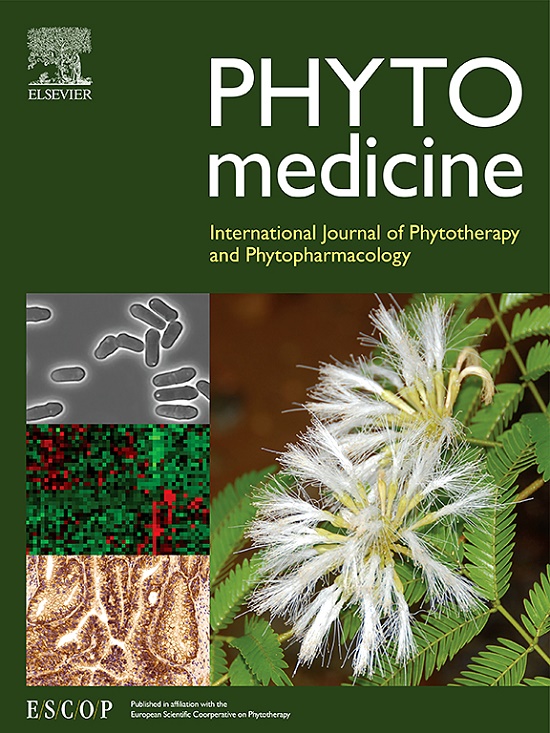Suyin Detoxification Granule alleviates trimethylamine N-oxide–induced tubular ferroptosis and renal fibrosis to prevent chronic kidney disease progression
IF 6.7
1区 医学
Q1 CHEMISTRY, MEDICINAL
引用次数: 0
Abstract
Background
Trimethylamine N-oxide (TMAO), a gut microbiota metabolite, is a risk factor for chronic kidney disease (CKD) progression. Suyin Detoxification Granule (SDG) is a traditional Chinese medicine preparation that has been proven to significantly reduce renal function damage and serum TMAO levels in patients with CKD. However, its specific mechanism remains unclear.
Purpose
This study investigated the role of TMAO-induced ferroptosis in CKD, and further explored the mechanism of SDG in improving TMAO-induced kidney injury.
Methods
A TMAO renal tubular epithelial cell injury model was constructed in vitro. After using freeze-dried powder of Suyin Detoxification Prescription (SDP), proteomic analysis, Western blotting, ferroptosis phenotype-related detection, and ELISA were performed to explore its mechanism. In vivo, a adenine-induced CKD model was established, with or without a high-choline diet to observe the impact of TMAO on CKD, and SDG or 3,3-Dimethyl-1-butanol (DMB, a TMAO inhibitor) was used for intervention. The composition of gut microbiota was analyzed using 16SrRNA sequencing, and the effect of SDG on gut-derived TMAO-induced kidney injury under the background of CKD was evaluated by pathological staining, immunoblotting, immunohistochemistry, and fluorescence staining.
Results
In vitro, TMAO could induce ferroptosis and secrete profibrotic factors in NRK-52E cells. SDP could inhibit TMAO-induced ferroptosis and reduce the secretion of profibrotic factors. The amelioration of ferroptosis by SDP was also verified in RSL3-induced cells. In vivo, our results demonstrated that gut-derived TMAO could promote CKD progression by inducing tubular ferroptosis, profibrotic factors expression and renal fibrosis. In addition, we illustrated that SDG might reduce circulating TMAO levels by down-regulating the gut microbiota related to TMAO (including Muribaculaceae, Bacteroides and Ruminococcaceae_UCG-010). Furthermore, SDG could prevent CKD progression by reducing TMAO-induced renal damage.
Conclusion
SDG reduced circulating TMAO levels by regulating gut microbiota and inhibited TMAO-induced renal tubular ferroptosis, profibrotic factors secretion, and renal fibrosis to prevent CKD progression.

舒阴解毒颗粒能缓解三甲胺N-氧化物诱导的肾小管铁变态反应和肾脏纤维化,防止慢性肾脏病恶化。
背景:三甲胺 N-氧化物(TMAO)是一种肠道微生物群代谢产物,是慢性肾脏病(CKD)恶化的危险因素。素阴解毒颗粒(SDG)是一种传统中药制剂,已被证实能明显减轻 CKD 患者的肾功能损伤和血清 TMAO 水平。目的:本研究探讨了 TMAO 诱导的铁变态反应在 CKD 中的作用,并进一步探讨了 SDG 改善 TMAO 诱导的肾损伤的机制:方法:在体外构建了 TMAO 肾小管上皮细胞损伤模型。方法:在体外构建了一个 TMAO 肾小管上皮细胞损伤模型,使用苏银解毒片(SDP)冻干粉,通过蛋白质组学分析、Western 印迹、铁突变表型相关检测和 ELISA 等方法探讨其机制。在体内,建立了腺嘌呤诱导的 CKD 模型,通过高胆碱饮食或不高胆碱饮食观察 TMAO 对 CKD 的影响,并使用 SDG 或 3,3-二甲基-1-丁醇(DMB,一种 TMAO 抑制剂)进行干预。利用16SrRNA测序分析了肠道微生物群的组成,并通过病理染色、免疫印迹、免疫组织化学和荧光染色评估了SDG对CKD背景下肠道源性TMAO诱导的肾损伤的影响:结果:在体外,TMAO能诱导NRK-52E细胞发生铁变态反应并分泌促组织坏死因子。SDP 可抑制 TMAO 诱导的铁卟啉沉积,并减少组织坏死因子的分泌。在 RSL3 诱导的细胞中也验证了 SDP 对铁突变的改善作用。在体内,我们的研究结果表明,肠道来源的 TMAO 可通过诱导肾小管铁变态反应、促坏死因子的表达和肾脏纤维化来促进 CKD 的进展。此外,我们还发现 SDG 可通过下调与 TMAO 相关的肠道微生物群(包括 Muribaculaceae、Bacteroides 和 Ruminococcaceae_UCG-010)来降低循环中的 TMAO 水平。此外,SDG 还能减少 TMAO 引起的肾损伤,从而预防慢性肾功能衰竭的恶化:结论:SDG 可通过调节肠道微生物群降低循环中的 TMAO 水平,并抑制 TMAO 诱导的肾小管铁变态反应、嗜碱性因子分泌和肾脏纤维化,从而预防 CKD 的恶化。
本文章由计算机程序翻译,如有差异,请以英文原文为准。
求助全文
约1分钟内获得全文
求助全文
来源期刊

Phytomedicine
医学-药学
CiteScore
10.30
自引率
5.10%
发文量
670
审稿时长
91 days
期刊介绍:
Phytomedicine is a therapy-oriented journal that publishes innovative studies on the efficacy, safety, quality, and mechanisms of action of specified plant extracts, phytopharmaceuticals, and their isolated constituents. This includes clinical, pharmacological, pharmacokinetic, and toxicological studies of herbal medicinal products, preparations, and purified compounds with defined and consistent quality, ensuring reproducible pharmacological activity. Founded in 1994, Phytomedicine aims to focus and stimulate research in this field and establish internationally accepted scientific standards for pharmacological studies, proof of clinical efficacy, and safety of phytomedicines.
 求助内容:
求助内容: 应助结果提醒方式:
应助结果提醒方式:


